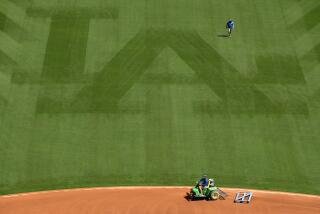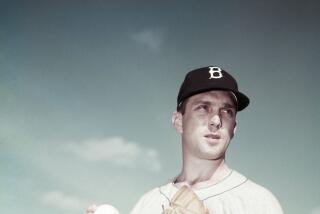Want the Real Deal? Go See Cal
Shed no tears for major league baseball as its television ratings plummet like a dying quail over second base and its turnstile counts strain to break into the fifth digit. Baseball is getting what it deserves. When you don’t care enough not to cancel the World Series, how can you expect the people to care about Milwaukee-Kansas City as the last days of May swirl down the drain pipe?
Suddenly, all the old gripes about baseball have been amplified and fleshed out into brow-furrowing debates that find their way onto national magazine covers and TV talk shows.
Is the game too boring?
Are the games too slow?
Has the game’s arteries hardened?
The game needs a PR magician, but short of that, it needs a savior.
Short of that, it will have to make do with Cal Ripken, who is authoring the brightest story of this dreary baseball season by simply doing what the fans wanted all along and what was ripped away from them last August.
Ripken plays ball.
That’s it. He shows up for work every day, puts in an honest nine innings, plays the game the way it ought to be played--the way it used to be played.
Without interruption.
Ripken’s consecutive-games streak is now nearing a crossroad that has seemed inevitable since the late 1980s: Lou Gehrig’s record of 2,130 games played in succession. Before Ripken, Gehrig’s mark was regarded as the Holy Grail of the sport, as unassailable as Joe DiMaggio’s 56-game hitting streak. But now, Ripken’s 2,130th is only weeks away--Sept. 6, against the Angels, is the due date--and has become just another calendar number to plan for, like Easter or the Fourth of the July.
Sept. 6, 1995.
Labor Day.
Ripken’s streak has been with us for so long that it has become routine, part of the game itself. The national anthem, the seventh-inning stretch and Ripken’s streak. If the Baltimore Orioles are playing tonight, Ripken’s playing tonight. There are legions of teen-agers in black-and-orange Oriole caps today who have never known it any other way.
It is a big deal, yet it is no big deal. As Ripken put it the other day at Anaheim Stadium, “I don’t look at this as chasing a home run record or a consecutive-game hitting streak. Those things are all performance-related . . . Basically, I show up and play every day.
“There’s no pressure that builds over having to get a hit or hit a home run. I can only imagine what it was like for Roger Maris trying to hit 61 home runs. I saw Paul Molitor in the middle of his 39-game hitting streak and how that builds into a pressure situation. How he feels like he has to get a hit every single time up.
“None of that happens here. I just have to show up and play.”
Now that’s Cal being modest, words to toast with a tall cold one (make it 1% milk fat), but words that don’t do justice. Ripken started this streak in 1982. Times have changed. Ripken’s streak is approaching its apex in the middle of the my-body-is-no-temple, it’s-a-$6-million-investment 1990s, where players get theirs and then if they twist, sprain or strain theirs, they lock themselves in the trainer’s room for complete home stands.
Ripken’s streak meant enough to Sparky Anderson that when the vile specter of replacement baseball threatened to scuttle 13 years of day-to-day work, the Detroit manager refused to manage until the real players returned.
“Cal Ripken’s streak is the greatest feat we have going,” Anderson says. “If you take away Cal Ripken’s streak, the greatest feat baseball has, what’s left? What do you do? It was hard on the game to miss a World Series. Now you do this and what are you going to have 25 years from now? You’re going to have a record book, and a history, that’s means nothing.”
As for the here and now, Ripken’s streak may mean even more. John Maroon, the Oriole publicity director overseeing Cal Across America--a whistle-stop tour with one group 20-minute interview session with Cal per city--describes the streak as “a positive baseball story” and those, in 1995, are as rare as a sighting on an unassisted triple play.
“It’s so important,” Maroon says. “We’re in Seattle the other day and [Ken] Griffey breaks his wrist, he’s out three months. What a time to lose a star like that.
“Baseball needs this streak more than ever. Cal’s pretty aware of that, but you’ll never hear him say, ‘What I’m doing is important to the game.’ He’s so modest, so unassuming.”
So modest and so unassuming that the casual ESPN2 viewer probably doesn’t know much more about the man hunting down this monumental athletic milestone except that he really, really, really likes to play baseball.
“One writer has called Cal ‘The Amazing Boring Man,’ ” Maroon says, wincing with every word. “Cal is low key. You don’t read about him driving his car 100 miles an hour. You don’t read about him out on the town with women.
“He’s not Deion. He’s not Shaq. He doesn’t have an album out or a rap song. He doesn’t talk trash. There’s nothing sexy about him, in a sense. When he hits a home run, he doesn’t strut or watch it.
“He just plays hard and runs hard. He doesn’t aspire to be anything except a baseball player.”
A baseball player who plays. In 1995, post-Selig, in the era of Fehr, that may be more marketable than it sounds.
Ripken will try to tell you that you “can’t compare me to Lou Gehrig. He was a phenomenal player, probably one of the best that’s ever played the game. I am not. He’s a better hitter, he hit for a higher average, he drove in more runs. Maybe you can say we have the same desire and same commitment, but beyond that, there is no comparison.”
You don’t have to believe him, however.
Gehrig and Ripken are linked by a long string of baseball games--and by what each meant to the game during his particular point in history. If Gehrig represented what baseball ought to aspire to during the ‘20s and ‘30s, so too, does Ripken in the ‘90s.
“It’s about time baseball had a guy like that again,” Maroon says. “A good guy, who cares about the game and the fans immensely. A guy who drinks milk. What’s wrong with that?”
More to Read
Go beyond the scoreboard
Get the latest on L.A.'s teams in the daily Sports Report newsletter.
You may occasionally receive promotional content from the Los Angeles Times.










